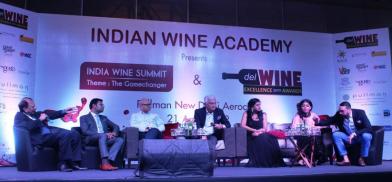India's growing wine industry: Promoting healthy drinking and a job provider
It is not surprising anymore to visit a restaurant in Delhi, Mumbai or Bangalore and find table after table ordering a glass or a bottle of wine with food. Go to a department store or a wine shop and you find even women shopping for wines

It is not surprising anymore to visit a restaurant in Delhi, Mumbai or Bangalore and find table after table ordering a glass or a bottle of wine with food. Go to a department store or a wine shop and you find even women shopping for wines. About 85% of these wines are made in India, ranging from Rs. 150- 4500; most of them were not even around barely 20 years ago. Wine culture is slowly catching on in India, known otherwise as a country of hard liquor drinkers.
Although a look into the country’s ancient scriptures reminds us of the royal courts imbibing a drink that was perhaps fermented, wine came more into vogue during the Mughal kings who ruled India from the early 16th century to the mid-19th century. There are records of merchants coming with their wines from Shiraz in Persia (now Iran), selling red wine to the top rung of society. They seem to have even persuaded some locals to grow grapes and make wine locally.
We had grape and wine production in small parts in India with the British encouraging the production for their use in the 19th century. There are records of wine being produced in Kashmir and parts of Sahyadari Hills in Maharashtra. Post phylloxera, a grapevine fest infestation, in 1890-1900 when the vineyards were destroyed, the British did not encourage the restart of the industry in India due to social pressures against wine and alcohol.
In the post-independence (1947) period wine was being consumed mainly in Goa due to Portuguese colonial influence and, in fact, the 1960s saw the production of cheap Goan Port wine costing under $2. It was fortified wine made by fermenting grapes and mixing with molasses, flavours and adding alcohol. This was the period of Golconda and Bosca wines.
Modern-day wine production was pioneered by Champagne Indage which produced Marquis de Pompadour sparkling wine with foreign collaboration in the 1980s and later Riviera and Chantilly brand wines that enjoyed some popularity because of monopoly. The credit for introducing varietals however, goes to the Grover and Sula companies in the mid-late 1990s and that is considered a benchmark for modern-day winemaking.
Wine culture in India actually took off in 2001 when the government allowed free import of wines and Maharashtra announced a model excise policy, waived excise duty and offering incentives. Starting with a few wineries, the state boasts about 90 wineries today. It also imposed import duties as a deterrent for wines from other states like Grover Vineyards in Karnataka which has about 10% of the national market share in the above Rs. 200 segment.
During this period of the 1980s and early 2000 the cheaper fortified wines also continued to grow, especially in the south and southwest of India. Today, there is a consumption of about 2.5 million cases with over 1 million cases of cheap wines and about 400,000 cases of imported wines annually. This represents less than 2% of the total alcoholic beverage market. There has been a growth of around 10-12% during the last 20 years with a severe drop during the global meltdown during 2008-2010.
Women, especially middle-class women and young people, have been driving the growth of wine culture in India. Increased tourism overseas has also contributed to people falling in love with wine. Another factor is the health benefits touted by the doctors. For the same reason 55-60% of the wine consumed is red with 45% being white; the balance is Rose and sparkling wine which is increasing in consumption faster.
Known as the Napa Valley of India, Nashik, in Maharashtra, is not necessarily the best production area. Arguably, Karnataka terroir offers better opportunity. Miniscule portions are produced in other states - Kashmir is out of reach due to political and religious reasons but the foothills of Uttaranchal and Himachal Pradesh have a great potential. Being nearer the equator India has two crops of grapes but, due to the monsoons, winemakers prune their vines to keep one crop for wine grapes, making January-March as the harvest season.
Indian wines are gradually getting to be discovered, but only about 5% is exported because the prices are not internationally competitive. Due to continual premiumization, higher-priced and higher quality wines are being added to the portfolio with upper end of the spectrum selling for up to Rs. 4500 ($65) a bottle. However, wines are accepted very well for their flavour profile by the expats visiting and tasting the wines. This has also resulted in an increase in wine tourism. The leading producer Sula Vineyards making over a million cases a year gets 350,000 visitors a year to its winery. Others are emulating its success gradually after many lost opportunities.
Unfortunately, the growth of the industry is not as fast as it despite increasing numbers drinking wine: there were less than 50,000 in 2001-today there are around 4- 5 million. Bureaucracy and government policies are a roadblock.
The government treats wine at par with hard liquor which has a social stigma attached to it. Genesis of this is India’s Constitution: Article 47 directs that the states shall endeavour to bring about prohibition of alcohol and drugs injurious to health. Politicians use this as a cash cow by raising taxes and attempting to decrease consumption. Out of 29 states and 7 union territories, the states of Bihar, Gujarat, Mizoram and Nagaland as well as in the union territory of Lakshadweep have prohibition.
Producers try to be in tune with the trends in the world. Sula introduced screwcaps on their bottles around 15 years and a majority of producers followed suit. It introduced red sparkling wines and recently ‘wine in the can’. It is a leader in sustainability, energy-saving and using the latest technology. Grover is innovating by using optical sorters, egg-shaped fermenters and amphorae. It has even bought a winery in Burgundy, France. Fratelli has introduced Italian grapes and winemaking.
KRSMA is a boutique winery that has made top quality wines despite acute wine shortage and exporting to the US. They are all selling their wines at Michelin-starred restaurants.
There is no doubt that India has a bright future for wine, not only to check alcoholism, but also as a job provider to farmers. The speed will depend upon the government and how winemakers improve the quality without increasing prices.
(The writer is President, Delhi Wine Club and Indian Wine Academy. He can be contacted at winguyindia@gmail.com)














Post a Comment